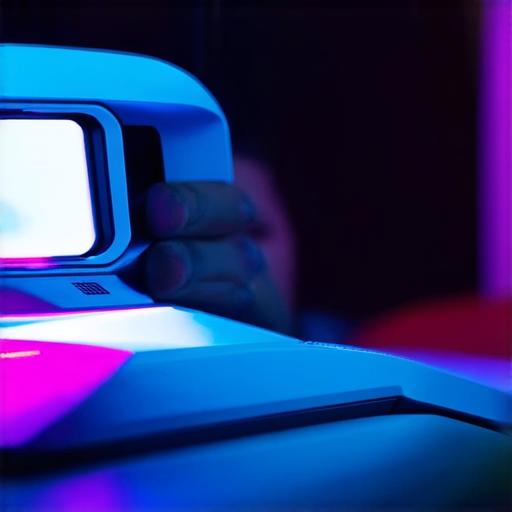
Smartphones and Tablets
Smartphones and tablets have become a staple in our lives, and many of them now include built-in AR technology. Apple’s ARKit, Microsoft’s HoloLens, and Google’s ARCore are some of the most popular AR development frameworks for smartphones and tablets.
One example of AR being used on a smartphone is Snapchat’s augmented reality filters. These filters allow users to add virtual objects, like hats or glasses, to their photos and videos. This creates a more immersive experience for the user and allows them to see things from a new perspective.
Another example of AR on a tablet is the use of AR in education. Teachers can use AR apps to create interactive lessons that engage students and allow them to learn in a more hands-on way. For example, an app called “Solar System Explorer” allows students to explore the solar system in 3D using their tablet’s camera.
Gaming Consoles
Gaming consoles have also started to incorporate AR technology into their platforms. Sony’s PlayStation VR and Microsoft’s Xbox One both include built-in AR technology that enhances the gaming experience.
One example of AR being used in gaming is the game “The Last Guardian” on the PlayStation 4. The game uses AR to create an immersive environment that responds to the player’s movements and actions. This creates a more interactive and engaging experience for the player.
Another example of AR in gaming is the use of augmented reality markers in sports games like “FIFA World Cup” and “MLS Soccer.” These markers allow players to scan their surroundings using their smartphones or tablets, and then see virtual objects and characters appear on the screen. This creates a more interactive and immersive experience for the player.
Smart Glasses
Smart glasses are another device that uses AR technology. These glasses have a built-in display that overlays information onto the user’s field of view. Some popular smart glasses include Google Glass and Vuforia
Smart Glasses
.
One example of smart glasses being used in healthcare is the use of smart glasses to assist surgeons during surgery. These glasses allow the surgeon to see additional information, such as patient vital signs and surgical tools, without having to look away from their patient. This improves efficiency and accuracy during surgery.
Another example of smart glasses being used in sports is the use of smart glasses by tennis players to track their performance metrics. These glasses allow the player to see data such as speed, distance, and accuracy, which helps them improve their game.
Augmented Reality Headsets
Augmented reality headsets are a more specialized type of device that uses AR technology to create an immersive experience for the user. Some popular AR headsets include Oculus Rift, HTC Vive, and PlayStation VR.
One example of AR being used in healthcare is the use of AR headsets in therapy. These headsets allow patients to see virtual objects and environments that help them overcome phobias or anxiety disorders. For example, a patient with a fear of heights can use an AR headset to simulate a virtual environment with a tall building and gradually work their way up.
Another example of AR in entertainment is the use of AR headsets in movies and TV shows. These headsets allow viewers to see additional information and interact with the characters on screen. For example, viewers can use an AR headset to see additional information about the history of a location in a movie or TV show.
Comparing AR Devices
When it comes to comparing different AR devices, there are a few key factors to consider. These include the device’s resolution, field of view, and battery life.
Smartphones and tablets typically have lower resolutions than dedicated AR headsets, but they are more widely available and can be used in a variety of settings. Gaming consoles and smart glasses have higher resolutions but may not be as widely available or compatible with as many apps. Augmented reality headsets have the highest resolution and field of view but require a separate device to run and may only be suitable for specific use cases.
In terms of battery life, smartphones and tablets tend to have the longest battery life, followed by gaming consoles and then AR headsets and smart glasses.
FAQs
1. What is augmented reality (AR)?
Augmented reality is a technology that overlays digital information onto the real world, creating an immersive experience for the user.
2. What devices use AR technology?
Smartphones and tablets, gaming consoles, smart glasses, and augmented reality headsets are all devices that use AR technology to varying degrees.
3. How does AR technology work?
AR technology works by using sensors and cameras on a device to track the user’s surroundings and then overlaying digital information onto the real world in real-time.
4. What are some examples of AR being used in education?
AR can be used in education to create interactive lessons that engage students and allow them to learn in a more hands-on way. For example, an app called “Solar System Explorer” allows students to explore the solar system in 3D using their tablet’s camera.
5. What are some examples of AR being used in healthcare?
AR can be used in healthcare to assist surgeons during surgery and to help patients overcome phobias or anxiety disorders. For example, a patient with a fear of heights can use an AR headset to simulate a virtual environment with a tall building and gradually work their way up.
Summary
In conclusion, augmented reality technology is becoming increasingly popular in recent years, with a wide range of devices using it to enhance user experience. Whether you’re using a smartphone, gaming console, smart glass, or augmented reality headset, there are many ways that AR can be used to create more immersive experiences for users. With the continued development of AR technology, we can expect to see even more exciting and innovative uses of this technology in the future.
